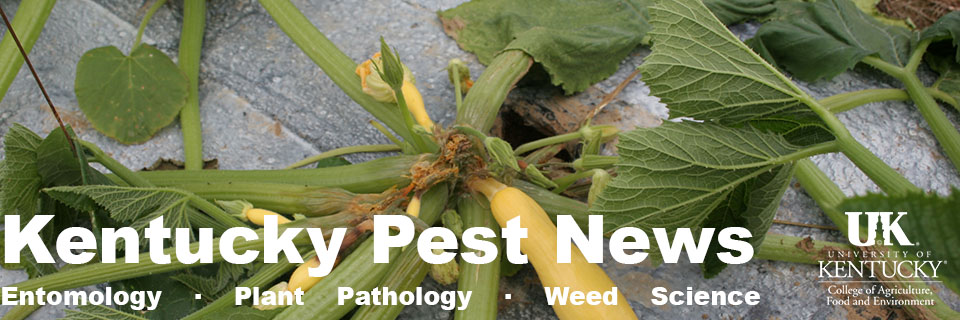Extension agents and stakeholders, please note that the UK Extension Plant Pathology Team has shifted several major responsibilities. Going forward, those Extension responsibilities that directly affect crop producers and affiliated professions are listed below. Paul Vincelli: Turfgrasses and forest trees…
Monthly Archives: September 2017
Strawberry Viruses
There are several virus diseases that can affect strawberry. They occur rarely or infrequently, but transmission via imported cuttings can occur. This fall, we have seen suspect viruses in planting stock. The viruses strawberry mottle virus (SMoV) and strawberry mild…
2017 Insect Trap Counts
Trap counts for major insect pests are provided by the Kentucky IPM Program. Traps are located at the UK Research and Education Center in western Kentucky and the UK Spindletop Farm in Lexington. Below are trap counts for the current…
Soybean Stem Borer: An Unnoticed Bug That May Cause Problems during Harvest and Reduce Yields in Soybeans
Biology & Phenology of Dectes Stem Borer in Kentucky The adult Dectes stem borer, Dectes texanus texanus (Coleoptera: Cerambycidae), is a long horned beetle approximately 3/8 inch long and gray in color. It has long, slender antennae that can be…
2017 Insect Trap Counts
Trap counts for major insect pests are provided by the Kentucky IPM Program. Traps are located at the UK Research and Education Center in western Kentucky and the UK Spindletop Farm in Lexington. Below are trap counts for the current…
Update on Soybean Rust
With soybean rust being observed in late August in Giles County, Tennessee (south-central TN), and with Hurricanes Harvey and Irma potentially carrying and depositing spores of the soybean rust fungus along its path, the detection of soybean rust in Kentucky…
Copious Amounts of Honeydew Produced by Sugarcane Aphids Attracts Bees and Other Insects: Do We Need To Be Worried?
Do we need to be concerned about bees feeding on honeydew produced by sugarcane aphids in sorghum fields? This is a question heard on repeated occasions when visiting sorghum fields infested by sugarcane aphids, and it was recently e-mailed to…
Bringing the Web to Your Yard
Several web-making caterpillars can be active in late summer. They cooperate to bind leaves and branches together into unsightly, but protective, nests where the can feed more or less undisturbed. Species active at this time of year include the relatively…
The Golden Argiope or Common Spider
The golden argiope is one of the more spectacular, and sometimes the most alarming, spider that we see in early fall. They may bite if bothered but are not dangerous. This orb weaver spider makes a flat, wheel-like web with…
Watch Out for Flannel Moth Caterpillars
There are several species of flannel caterpillars that may be encountered. The ones most commonly reported in Central and Eastern Kentucky are the black wave flannel moth caterpillar and the white flannel moth caterpillar. Both have painful stinging hairs if…
Fly Strike in Calves
Calving presents the opportunity for fly strikes. Fly strike begins when a female blow fly, usually metallic green bottle fly, lays a small batch of oblong white eggs on an attractive site. These scavenger flies do not deposit eggs on…
Plant Disease Diagnostic Lab Highlights
The following plant disease highlights from the University of Kentucky Plant Disease Diagnostic Laboratories represent recent sample submissions from field crops, fruit, vegetables, and ornamentals. Diagnostic samples of agronomic crops from the past week have included southern rust and gray…
Avoid Making Cover Crops a Pest
The use of cover crops in Kentucky is on the rise with more farmers looking to gain an edge wherever they can. Cover crops have many benefits, including keeping soils in place over winter, improving soil quality, and in some…
Spider Mites Active on Vegetables
The hot, dry conditions we experienced earlier this month have brought on two-spotted spider mite problems in some areas. Unlike many insect problems, we are alerted to mite infestations by the symptoms of their damage rather than seeing the mites…
Adjuvants and Surfactants; Some Labels Require Them
I have had several contacts with applicators this summer who stated “I used product X according to recommendations and it didn’t work at all.” After making sure they used the correct rates, had thorough coverage, and used the correct product…
